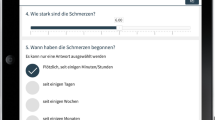Abstract
Background
Patient-administered computerized questionnaires represent a novel tool to assist primary care physicians in the delivery of preventive health care.
Objective
The aim of this study was to assess patient-reported ease of use with a self-administered tablet computer-based questionnaire in routine clinical care.
Design
All patients seen in a university-based primary care practice were asked to provide routine screening information using a touch-screen tablet computer-based questionnaire. Patients reported difficulty using the tablet computer after completion of their first questionnaire.
Patients
Ten thousand nine hundred ninety-nine patients completed the questionnaire between January 2004 and January 2006.
Measurements
We calculated rates of reporting difficulty (no difficulty, some difficulty, or a lot of difficulty) using the tablet computers based on patient age, sex, race, educational attainment, marital status, and number of comorbid medical conditions. We constructed multivariable ordered logistic models to identify predictors of increased self-reported difficulty using the computer.
Results
The majority of patients (84%) reported no difficulty using the tablet computers to complete the questionnaire, with only 3% reporting a lot of difficulty. Significant predictors of reporting more difficulty included increasing age [odds ratio (OR) 1.05, 95% confidence interval (CI) 1.05–1.05)]; Asian race (OR 2.3, 95% CI 1.8–2.9); African American race (OR 1.4, 95% CI 1.2–1.6); less than a high school education (OR 3.0, 95% CI 2.6–3.4); and the presence of comorbid medical conditions (1–2: OR 1.3, 95% CI 1.2–1.5; ≥3: OR 1.7 95% CI 1.5–2.1).
Conclusions
The majority of primary care patients reported no difficulty using a self-administered tablet computer-based questionnaire. While computerized questionnaires present opportunities to collect routine screening information from patients, attention must be paid to vulnerable groups.
Similar content being viewed by others
References
Bachman JW. The patient-computer interview: a neglected tool that can aid the clinician. Mayo Clin Proc. 2003;78(1):67–78.
Bliven BD, Kaufman SE, Spertus JA. Electronic collection of health-related quality of life data: validity, time benefits, and patient preference. Qual Life Res. 2001;10(1):15–22.
McGuire M, Bakst K, Fairbanks L, et al. Cognitive, mood, and functional evaluations using touchscreen technologies. J Nerv Ment Dis. 2000;188(12):813–7.
Jette AM, Davies A, Cleary PD, et al. The functional status questionnaire: reliability and validity when used in primary care. J Gen Intern Med. 1986;1(3):143–9.
Feigelson ME, Dwight SA. Can asking questions by computer improve the candidness of responding? A meta-analytic perspective. Consult Psychol J: Prac Res. 2000;52(4):248–55.
US Preventive Services Task Force. Genetic risk assessment and BRCA mutation testing for breast and ovarian cancer susceptibility: recommendation statement. Ann Intern Med. 2005;143(5):355–61.
US Preventive Services Task Force. Screening for suicide risk: recommendation and rationale. Ann Intern Med. 2004;140(10):820–1.
US Preventive Services Task Force. Screening and behavioral counseling interventions in primary care to reduce alcohol misuse: recommendation statement. Ann Intern Med. 2004;140(7):554–6.
US Preventive Services Task Force. Screening for family and intimate partner violence: recommendation statement. Ann Intern Med. 2004;140(5):382–6.
US Preventive Services Task Force. Screening for thyroid disease: recommendation statement. Ann Intern Med. 2004;140(2):125–7.
US Preventive Services Task Force. Screening for obesity in adults: recommendations and rationale. Ann Intern Med. 2003;139(11):930–2.
US Preventive Services Task Force. Screening for type 2 diabetes mellitus in adults: recommendations and rationale. Ann Intern Med. 2003;138(3):212–4.
US Preventive Services Task Force. Screening for colorectal cancer: recommendation and rationale. Ann Intern Med. 2002;137(2):129–31.
US Preventive Services Task Force. Screening for depression: recommendations and rationale. Ann Intern Med. 2002;136(10):760–4.
Yarnall KS, Pollak KI, Ostbye T, Krause KM, Michener JL. Primary care: is there enough time for prevention? Am J Public Health. 2003;93(4):635–41.
Tsui JI, Dodson K, Jacobson TA. Cardiovascular disease prevention counseling in residency: resident and attending physician attitudes and practices. J Natl Med Assoc. 2004;96(8):1080–3. 1088–91.
Melin I, Karlstrom B, Berglund L, Zamfir M, Rossner S. Education and supervision of health care professionals to initiate, implement and improve management of obesity. Patient Educ Couns. 2005;58(2):127–36.
Rollman BL, Hanusa BH, Gilbert T, Lowe HJ, Kapoor WN, Schulberg HC. The electronic medical record. A randomized trial of its impact on primary care physicians’ initial management of major depression [corrected]. Arch Intern Med. 2001;161(2):189–97.
Rollman BL, Hanusa BH, Lowe HJ, Gilbert T, Kapoor WN, Schulberg HC. A randomized trial using computerized decision support to improve treatment of major depression in primary care. J Gen Intern Med. 2002;17(7):493–503.
Bock B, Niaura , Fontes A, Bock F. Acceptability of computer assessments among ethnically diverse, low-income smokers. Am J Health Promot. 1999;13(5):299–304.
Hess , Matthews K, McNeil M, Chang CCH, Kapoor W, Bryce C. Health services research in the privacy age. J Gen Intern Med. 2005;20(11):1045–9.
Dickinson A, Gregor P. Designing computer systems for and with older users. Behav Inf Technol. 2007;26(4):273–4.
Hawthorn D. Interface design and engagement with older people. Behav Inf Technol. 2007;26(4):333–41.
Dickinson A, Arnott J, Prior S. Methods for human–computer interaction research with older people. Behav Inf Technol. 2007;26(4):343–52.
Larkin-Lieffers PA. The older adult and public library computer technology: a pilot study in a Canadian setting. Libri. 2000;50:225–34.
Main D, Quintela J, Araya-Guerra , Holcomb S, Pace W. Exploring patient reactions to pen-tablet computers: a report from CaReNet. Ann Fam Med. 2004;2(5):421–4.
Acknowledgments
The FAST is supported by the University of Pittsburgh’s Division of General Internal Medicine. Dr. Hess has grant support from the National Institutes of Health, Department of Health and Human Services, through the National Institute on Aging AG024254. Dr. McTigue has grant support from the National Institutes of Health, Department of Health and Human Services, through the National Institute of Diabetes and Digestive and Kidney Diseases DK067192.
Conflict of Interest
Dr. Hess has received research support from BIONOVO for A phase II, double-blind, placebo-controlled, randomized clinical trial assessing safety and efficacy of MF101 for hot flashes and menopausal symptoms in postmenopausal women. No other authors have conflicts to disclose.
Author information
Authors and Affiliations
Corresponding author
Rights and permissions
About this article
Cite this article
Hess, R., Santucci, A., McTigue, K. et al. Patient Difficulty Using Tablet Computers to Screen in Primary Care. J GEN INTERN MED 23, 476–480 (2008). https://doi.org/10.1007/s11606-007-0500-1
Published:
Issue Date:
DOI: https://doi.org/10.1007/s11606-007-0500-1




